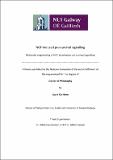| dc.contributor.advisor | Gorman, Adrienne | |
| dc.contributor.advisor | Samali, Afshin | |
| dc.contributor.author | Carleton, Laura | |
| dc.date.accessioned | 2014-06-26T15:30:37Z | |
| dc.date.available | 2016-02-11T13:31:33Z | |
| dc.date.issued | 2014-01-27 | |
| dc.identifier.uri | http://hdl.handle.net/10379/4431 | |
| dc.description.abstract | Nerve growth factor (NGF) is a potent pro-survival growth factor that has diverse roles in development and in the adult nervous system. It has two cognate receptors that stimulate distinct signalling pathways, tropomyosin-related kinase A (TrkA) and the 75 kDa neurotrophin receptor (p75NTR). NGF activation of TrkA induces proliferation and survival in neuronal cells, while activation of p75NTR causes either cell death or cell survival depending on the cell context. Alteration of NGF signalling has been implicated as a possible therapeutic in many human diseases such as Alzheimer's disease, chronic pain and breast cancer. However, poor understanding of p75NTR receptor stimulation, limits the therapeutic potential of the NGF ligand. My research aim is to investigate a novel mechanism of NGF stimulated pro-survival signalling through TrkA, where at late stages of the apoptosis pathway it protected cells and increased their long-term survival. A further aim is to generate NGF variants to enhance NGF-mediated pro-survival signalling.
It is shown here that NGF activation of TrkA prevents cell death by targeting two stages of the apoptosis pathway, i.e., both before and after mitochondrial outer membrane permeabilisation (MOMP). MOMP is considered to be the point in which a cell commits to undergoing apoptosis. However, NGF treatment, at a time point where a significant amount of cells have lost their mitochondrial membrane potential, can induce an increase in the long term survival of the cells and a reduction in the activity and protein level of active caspases. The data shown here suggest that the loss in active caspase-3, often considered the main executioner of apoptosis, is mediated by lysosomal degradation, which is stimulated by NGF-mediated activation the ERK arm of TrkA signalling.
A further aim was to develop a protocol for the transient expression and purification of His tagged NGF and NGF variants. All NGF constructs contained a His tag for the purification of the protein. The protocol was developed with wild type, HA and FLAG-tagged NGF. Briefly, this method involved the generation of NGF cDNA constructs that were transiently transfected into HEK293T where the protein was expressed and secreted into the media. The conditioned media was collected for purification by Nickel affinity chromatography. The binding affinities of these tagged NGFs as well as their biological activity through p75NTR and the TrkA receptor was analysed and compared to commercially available NGF. Using this protocol a range of NGF variants (8 variants) were also expressed. These variants were computationally designed by the FoldX computer algorithim to have altered affinity to its receptors with the aim of generating an NGF variant with enhanced pro-survival signalling. | en_US |
| dc.rights | Attribution-NonCommercial-NoDerivs 3.0 Ireland | |
| dc.rights.uri | https://creativecommons.org/licenses/by-nc-nd/3.0/ie/ | |
| dc.subject | NGF | en_US |
| dc.subject | Apoptosis | en_US |
| dc.subject | Mutagenesis | en_US |
| dc.subject | School of Natural Sciences | en_US |
| dc.title | NGF-induced pro-survivla signalling: Molecular engineering of NGFto enhance pro-survival signalling | en_US |
| dc.type | Thesis | en_US |
| dc.contributor.funder | Science Foundation Ireland | en_US |
| dc.local.note | NGF is a potent pro-survival factor. This thesis showed that NGF could prevent cell death by blocking two points in the cell death pathway, apoptosis. NGF was then mutated to enhance this pro-survival signalling, to prevent neuronal cell loss seen during Alzheimer's disease. | en_US |
| dc.local.final | Yes | en_US |
| nui.item.downloads | 163 | |


